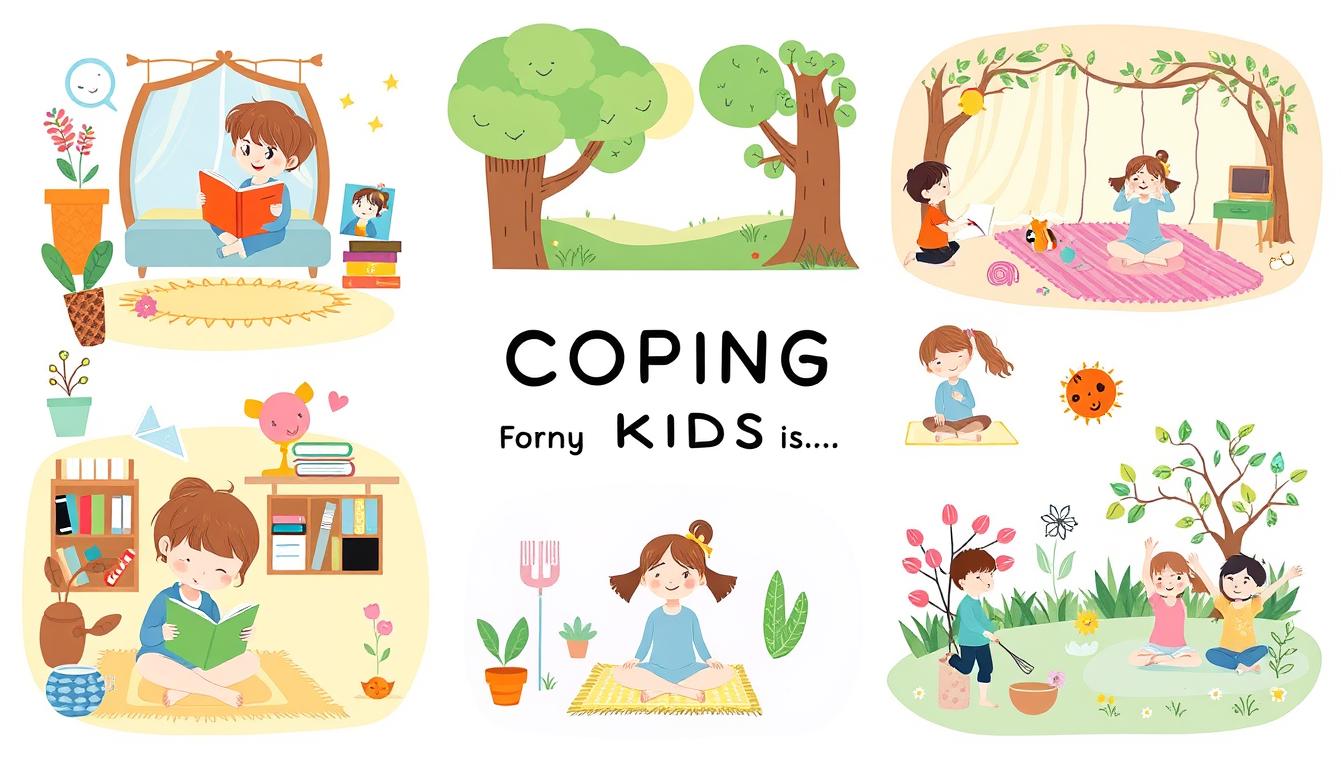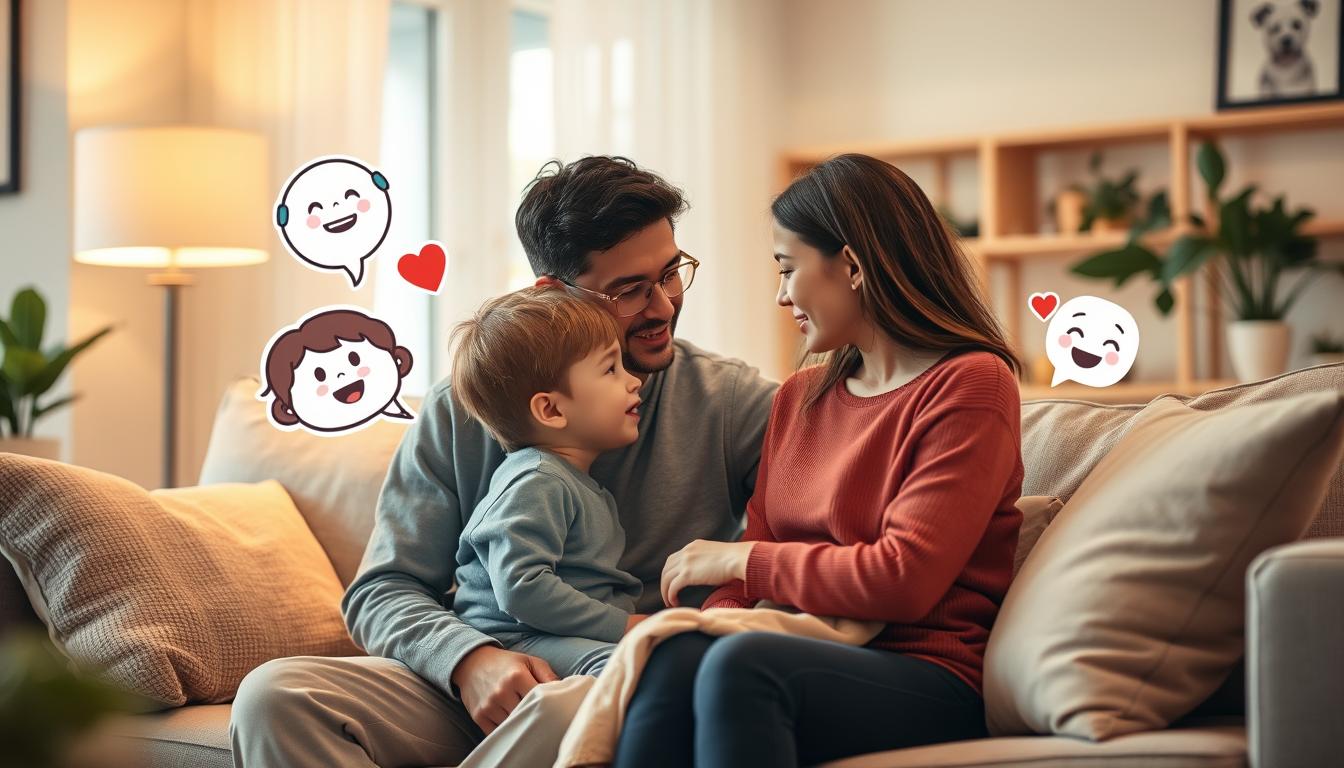Seeing your child stressed can worry you. But, there are ways to help them feel better. This guide will show you how to help your child manage stress and feel stronger.
Key Takeaways
- Understand the common triggers and signs of stress in children
- Discover mindfulness and relaxation exercises to calm young minds
- Implement daily stress relief routines for kids
- Encourage creative expression and physical activities for stress management
- Access support tools to empower parents and caregivers
Understanding Childhood Stress and Its Impact
As parents, we often underestimate the impact of stress on our children’s emotional well-being. Childhood is full of wonder and discovery, but it also comes with unique challenges. These challenges can lead to childhood stress. It’s important to understand the common triggers of stress and recognize the signs.
This knowledge is the first step in managing childhood worries and teaching emotional regulation strategies to our young ones.
Common Triggers of Childhood Stress
Children face stress from many sources. These include academic pressures, social challenges, family dynamics, and major life changes. Some common stressors are:
- Demanding school workloads and high expectations
- Bullying or peer conflicts in the schoolyard or online
- Parental divorce, separation, or family conflicts
- Traumatic events, such as the loss of a loved one
- Moving to a new home or starting at a new school
Physical and Emotional Signs of Stress in Children
Stress in children can show up in physical and emotional ways. Parents should watch for signs like:
- Frequent headaches or stomachaches
- Changes in appetite or sleeping patterns
- Irritability, mood swings, or increased anxiety
- Difficulty concentrating or withdrawing from social activities
Why Early Intervention Matters
Recognizing stress in children and seeking childhood stress relief is key. Early action can prevent long-term mental health problems. It supports the child’s overall well-being.
By addressing stress sources and teaching emotional regulation strategies, we empower children. They can face growing up challenges with resilience and confidence.
Mindfulness and Relaxation Techniques for Young Minds
Childhood can be tough, but kids can learn to handle stress. Mindfulness and relaxation help them find calm and control their feelings. These practices are key for young minds to stay peaceful.
Guided imagery is a great way to help kids relax. They imagine a peaceful place, like a sunny meadow or a cozy treehouse. This helps them forget about worries and feel calm.
- Deep breathing is another helpful technique. Kids breathe slowly, feeling their belly rise and fall. It helps them stay calm.
- Meditation teaches kids to be in the moment. They sit quietly, watching their thoughts without judgment. It’s a way to stay present.
Using mindfulness techniques for kids, kid-friendly relaxation methods, and calming exercises for kids daily helps kids cope. These skills are important for their future.
| Mindfulness Technique | Benefits for Kids |
|---|---|
| Guided Imagery | Promotes relaxation, reduces stress and anxiety, boosts creativity |
| Deep Breathing | Calms the mind and body, improves focus and concentration |
| Meditation | Enhances self-awareness, emotional regulation, and overall well-being |
“Mindfulness is a way of being present, of slowing down, of paying attention. It’s a powerful tool for children to navigate the ups and downs of life.”
By using mindfulness techniques for kids, kid-friendly relaxation methods, and calming exercises for kids daily, kids can develop important coping skills. These skills will help them throughout their lives.
Stress Less: Coping Strategies for Kids
As parents, we always want the best for our kids. Helping them deal with stress is key. We’ll look at coping strategies for kids to help them build resilience and handle anxiety.
Building Daily Stress Relief Routines
Creating a daily routine can really help kids feel less stressed. Encourage them to do things like mindfulness, journaling, or just play. These activities help them manage their feelings and find ways to deal with worries.
Creative Expression and Emotional Release
Being creative is great for kids to manage anxiety. Support your kids in exploring art, music, or writing. These activities let them express themselves, feel good about what they do, and grow their confidence.
Physical Activities for Stress Management
Physical activity is key for resilience in youth. It could be sports, dancing, or just going for a walk. Exercise helps kids release stress, feel better, and handle tough times better. Make sure your child does these activities to stay healthy and manage stress.
| Coping Strategy | Benefits | Example Activities |
|---|---|---|
| Daily Stress Relief Routines | Promotes emotional regulation, reduces anxiety, and fosters a sense of control. |
|
| Creative Expression | Provides a healthy outlet for emotions, boosts self-confidence, and fosters creativity. |
|
| Physical Activities | Releases pent-up energy, improves mood, and enhances overall well-being. |
|
Every child is different, so what works for one might not work for another. Try out different coping strategies for kids to see what fits best. By teaching them these skills, you’ll help them grow strong and handle anxiety well.

Empowering Parents with Support Tools
As parents and caregivers, helping children manage stress is key. We need the right tools and strategies to support them. This way, we create a safe space for emotional growth and stress relief.
Start by talking openly with your kids. Let them share their feelings and worries without fear of judgment. Listen well, show you understand, and find ways to cope together.
- Engage in active listening to understand their perspective.
- Validate their feelings and let them know it’s okay to feel stressed.
- Collaborate on practical solutions to address the sources of stress.
Also, make your home a supportive place. Focus on activities that help with emotional balance, like mindfulness, exercise, and creativity. By showing these habits, we encourage our kids to manage their stress too.
“When we give children the tools to manage their emotions, we empower them to navigate life’s challenges with resilience and confidence.”
Being a parent means more than just supporting your kids. We must also take care of our own stress. This way, we can better help our children deal with their stress and emotions.

Every child is different, so what works for one might not work for another. Be open to trying various strategies until you find the right fit for your child. With patience and the right tools, we can help our kids overcome childhood stress and grow stronger.
Conclusion
As we wrap up our look at coping strategies for kids, it’s clear that teaching resilience and managing anxiety is key. Understanding what causes stress in kids and knowing the signs helps us support them. This way, we can help our children feel better.
The mindfulness and relaxation techniques we’ve talked about are great for kids. They help kids deal with stress in healthy ways. By teaching them to manage stress, we empower them to care for their own emotions.
The most important thing is to support kids with love and guidance. By teaching them how to handle stress, we help them grow strong and emotionally smart. This way, we prepare them for life’s challenges. Together, we can build a future where kids are ready to succeed.



